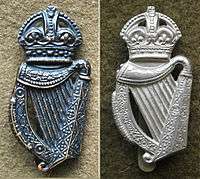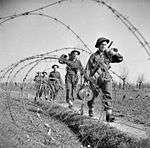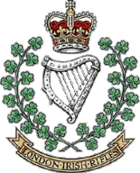London Irish Rifles
| London Irish Rifles | |
|---|---|
|
Crest of the London Irish Rifles | |
| Active |
1859 - 1919 1920 − Present Day |
| Country |
|
| Branch |
|
| Type | Infantry |
| Role | Rifles |
| Size | One company |
| Part of | London Regiment |
| Garrison/HQ | London District |
| Motto(s) | "Who shall separate us?" |
| March |
|
| Anniversaries |
St Patrick's Day (17 Mar) Loos (25 Sep) |
| Commanders | |
| Honorary Colonel | Major-General Sir Sebastian John Lechmere Roberts KCVO OBE |
| Insignia | |
| Tartan | Saffron (pipers kilts) |
| Hackle | St Patrick's Blue Hackle worn by Officers, Warrant Officers and Pipers. Dark Green Hackle worn by all other ranks. |
The London Irish Rifles (LIR) was a volunteer rifle regiment of the British Army with a distinguished history, and now forms 'D' (London Irish Rifles) Company of the London Regiment and is part of the Army Reserve. They are based at Connaught House, Flodden Road in Camberwell.
Victorian Era
The London Irish Rifles was originally formed in 1859 during the Victorian Volunteer Movement and named 28th Middlesex (London Irish) Rifle Volunteer Corps.
During the Second Boer War, the battalion sent eight officers and 200 private soldiers for active service. One officer won the Distinguished Service Order (DSO) and another member gained seven bars to his South Africa Medal. In recognition of their service, the London Irish was granted their first battle honour, "South Africa, 1900-1902".
In 1908, the London Irish was transferred to the Territorial Force and renamed the 18th (County of London) Battalion, the London Regiment (London Irish Rifles).
First World War
During the First World War, the LIR raised three Battalions, one of which stayed in reserve in England. The 1st Battalion was sent to France in 1915 and saw its first action at Festubert in May, before taking part in many of the major battles on the western front during the next three years. The 2nd Battalion served in France, Greece and Palestine.
At the Battle of Loos, the 1st Battalion LIR particularly distinguished itself. While storming across No-Man's Land to capture the enemy trenches, Rifleman Frank Edwards, the Captain of the football team, kicked a football along in front of the troops. This earned the LIR probably their most famous Battle Honour - "Loos, 1915". The Loos football is still preserved in the Regimental Museum, and to this day, the memory of Rifleman Edwards and his comrades is commemorated every year at Connaught House on Loos Sunday.
Over 1000 London Irishmen were killed during the conflict.
The following battle honours were gained by the two battalions of the London Irish Rifles during the First World War: "Festubert, 1915" "Loos, 1915" "Somme, 1916,'18" "Flers-Courcelette" "Morval" "Le Transloy" "Messines, 1917" "Ypres, 1917" "Langemarck, 1917" "Cambrai, 1917" "St Quentin" "Bapaume, 1918" "Ancre, 1918" "Albert, 1918" "Pursuit to Mons" "France and Flanders, 1915-18" "Doiran, 1917" "Macedonia, 1916-17" "Gaza" "El Mughar" "Nebi Samwil" "Jerusalem" "Jericho" "Jordan" "Palestine, 1917-18".
The following honours and awards were won by men of the London Irish Rifles during 1914-18: DSO - 7, MC - 33, DCM - 20, MM - 101.
Inter War

After the cessation of hostilities, the LIR was reduced to cadre strength, before being disbanded in May 1919 at Felixstowe. In February 1920, the 18th (County of London) Battalion of the London Regiment (London Irish Rifles) was reconstituted as a component of the 47th (2nd London) Infantry Division of the new Territorial Army, and in 1923, the designation of the Regiment was shortened to 18th London Regiment (London Irish Rifles).
During these years, ties between the London Irish Rifles and the Royal Ulster Rifles (RUR), which before 1921 was known as the Royal Irish Rifles, were greatly strengthened, and the London Irish became part of the Corps of the Royal Ulster Rifles (RUR) in 1929.
In 1937, when the London Regiment was disbanded, the LIR became known as London Irish Rifles, the Royal Ulster Rifles. After the 47th Division was also disbanded, the London Irish transferred to the 169th (3rd London) Infantry Brigade, part of 56th (1st London) Infantry Division.[1] Permanent staff were all seconded or attached from the RUR, but up to 1937, the Regimental Sergeant Major was normally found by the Irish Guards. The London Irish was one of the first Territorial units to start mechanisation by drawing up two "Commer" trucks.
The Regiment's piper-green head-dress, the Caubeen, which was worn by all Irish regiments, and was characterised by being sloped to the left instead of the right — only the LIR and Liverpool Irish having theirs sloping on the left - was adopted for wear by all ranks in 1937 in place of the service dress cap.
Second World War

In April 1939, the establishment of the Territorial Army was doubled in size and the 2nd Battalion, London Irish Rifles was reformed, initially as a component unit of the 4th London Infantry Brigade 2nd London Infantry Division which was a 2nd Line duplicate of the 1st Line 1st London Infantry Division.
The 70th (Young Soldiers) Battalion, a Young Soldiers company of the London Irish Rifles, was also formed early in 1940, and set up for men volunteering who were between the ages of eighteen and nineteen and a half. The objective was to train them to the highest standard of drill, skill-at-arms, discipline and turnout in preparation for the time when they would be fit to take their place within the 1st and 2nd battalions. The 70th (Young Soldiers) Battalion ceased to exist in January 1943, when all such units were disbanded.
A company of the 1st Battalion was involved in the Battle of Graveney Marsh, in September 1940 the last ground combat between a foreign invading force and British troops that happened on British mainland soil.[2][3]
The 1st Battalion, London Irish Rifles left England in August 1942 to serve in Iraq and Italy, and the 2nd Battalion sailed to North Africa with the 38th (Irish) Infantry Brigade in November 1942 before taking part in the Tunisian and Italian campaigns. The 1st Battalion formed part of the 168th (London) Infantry Brigade, primarily within the 56th (London) Infantry Division, taking part in major actions in Italy at Fosso Bottacetto south of Catania, Monte Camino, Monte Damiano, the Garagliano Crossing and Aprilia (Anzio), and at the Gothic Line, and as part of 167th (London) Infantry Brigade taking a leading role in the final Allied offensive in Northern Italy during April 1945.
In the month that they spent fighting in the Anzio beachhead, the 1st Battalion's casualties totalled 32 officers and 550 other ranks killed, wounded and missing. When embarking for rest at Pozzuoli near Naples, the battalion numbered just 12 officers and 300 other ranks, some of which had returned from hospital to rejoin the battalion.
During the action at Anzio, the following awards were issued;
Bar to Military Cross (MC): Major W E Brooks
Military Cross: Captain A Mace, Captain D A Hardy, Captain G R H Mullins, Captain R M Haigh, Lieutenant L Rue.
Distinguished Conduct Medal (DCM): Company Serjeant Major F Kelly, Serjeant HF Guy.
Military Medal (MM): Serjeant A Marson Corporal C Wilson Corporal C Hill.
The 2nd Battalion formed part of the 38th (Irish) Brigade, initially as part of 6th Armoured Division and later within the 78th Battleaxe Division, a division with an excellent reputation, and was in front line service from November 1942 to May 1945 throughout Tunisia and Italy including taking part in major actions at Bou Arada, Heidous, Centuripe, Termoli, Sangro River, the Liri Valley, Trasimeno, Monte Spaduro and at the Argenta Gap. The battalion garrisoned parts of Austria in the immediate post war period.
Over 600 London Irishmen were killed during the conflict.
The following battle honours were gained by the two battalions of the London Irish Rifles during the Second World War: "Bou Arada" "El Hadjeba" "Stuka Farm" "Heidous" "North Africa, 1942-43" "Lentini" "Simeto Bridgehead" "Adrano" "Centuripe" "Salso Crossing" "Simeto Crossing" "Malletto" "Pursuit to Messina" "Sicily, 1943" "Termoli" "Trigno" "Sangro" "Fossacesia" "Teano" "Monte Camino" "Calabritto" "Garigliano Crossing" "Damiano" "Anzio" "Carroceto" "Cassino II" "Casa Sinagoga" "Liri Valley" "Trasimene Line" "Sanfatucchio" "Coriano" "Croce" "Senio Floodbank" "Rimini Line" "Ceriano Ridge" "Monte Spaduro" "Monte Grande" "Valli di Comacchio" "Argenta Gap" "Italy, 1943-45".
The following honours and awards were won by men of the London Irish Rifles during 1939-45: DSO - 6, MC - 46 (4 with bar), DCM - 12, MM - 55, American Silver Star - 2, American Bronze Star - 2, Mentioned In Despatches - 103 (1 twice), GM - 2, BEM - 2, MBE - 2.
Post war
After the war, the Battalion re-formed as a Battalion of the Royal Ulster Rifles. In 1967, with the disbanding of the London Regiment, the three Irish Regular Infantry Regiments combined to form The Royal Irish Rangers, and the LIR became D Company (London Irish Rifles), 4th Battalion The Royal Irish Rangers, remaining so until the re-formation of The London Regiment in 1993. The Royal Irish Rangers later amalgamated with the Ulster Defence Regiment to form the Royal Irish Regiment, with the Northern Irish Territorial Army (TA) company remaining as Rangers.
The LIR moved from their historic home, Duke of York's Barracks, Chelsea to Flodden Road, Camberwell in 2000. In 2007 they opened a detachment for 13 Platoon at the TA Centre on Hammersmith Road in Hammersmith, but that venture proved unsuccessful and the Irish withdrew again in 2008. On 9 June 2012, during the Diamond Jubilee Freedom Parade held by the Royal Borough of Kensington & Chelsea for units holding Freedom of the Borough, the London Irish formally co-located with B Detachment of 256 (City of London) Field Hospital at their TA Centre at 1a Iverna Gardens, Kensington. This marked a return to the Borough for the London Irish Rifle, 14 years after leaving the Duke of York's HQ in Chelsea and the intention to recruit locally to build up a Platoon in the first instance. It is anticipated that there will be synergies to be exploited by having infantry and the various Field Hospital cap badges occasionally doing joint training on Training Nights.
Today
Since 1993 and the incorporation of the London Irish Rifles as a company of the London Regiment, soldiers from the London Irish Rifles have served in Bosnia, Kosovo, Iraq, Afghanistan and Cyprus. During Operation Telic, the Company contributed to the formation of Cambrai Company (Operation Telic 3) and Messines Company (Operation Telic 4), both of which were commanded by officers of the London Irish Rifles. Soldiers from the Company also deployed to Afghanistan with Somme Company in 2007 (Operation Herrick 7), Amiens Company in 2010 (Operation Herrick 12) and Arras Company in 2011 (Operation Herrick 13).[4]
On 4 October 2008, the LIR were given the freedom of the Royal Borough of Kensington and Chelsea in a ceremony at the Town Hall Kensington. This followed a march, with bayonets fixed, and review along Kensington High Street.
The London Irish Rifles train on Tuesday evenings at the Army Reserve Centre on Flodden Road in Camberwell, London SE5 9LL.
Dress
Their distinctive piper-green head-dress is called a Caubeen. The Caubeen was first worn by the Pipers of the Irish Guards. However, the London Irish Rifles were the first unit to adopt for wear by all soldiers. It was subsequently adopted for wear by all Irish infantry regiments, with the exception of the Irish Guards. In contrast to the rest of the British Army, the London Irish Rifles have the distinction of wearing the cap badge over the right eye and the Caubeen is pulled over the left ear.
The London Irish Rifles are also issued with a rifle green beret for use on exercise and/or on operations. The beret was approved for wear by the Army Dress Committee in 2001 and was first worn on operations in 2004.
See also
References
- ↑ "The London Division 1937-1938" (PDF). British Military History. Retrieved 30 April 2016.
- ↑ "Kent battle between German bomber crew and British soldiers marked after 70 years". The Daily Telegraph. 20 August 2010. Retrieved 20 August 2010.
- ↑ Green, Ron; Mark Harrison (30 September 2009). "Forgotten frontline exhibition tells how Luftwaffe fought with soldiers on Kent marshes". KentOnline.
- ↑ "London Parade for returning UK troops". The Daily Telegraph. 15 October 2007. Retrieved 30 April 2016.
Bibliography
- Ford, Ken (2003) [1999]. Battleaxe Division. Stroud, UK: Sutton Publishing. p. 273 pages. ISBN 0-7509-3199-X.
- Doherty, Richard (1994) [1993]. Clear The Way! History of the 38th (Irish) Brigade. Dublin, Ireland: Irish Academic Press. p. 336 pages. ISBN 0-7165-2542-9.
- All My Brothers By Edmund O'Sullivan. Contains an eyewitness account of serving in the 2nd Battalion of the London Irish Rifles from October 1939 until March 1946.
- The official history of the 1st and 2nd Battalions of the London Irish Rifles in the Second World War.
External links
- Irish Brigade The Story of the 38th (Irish) Brigade in the 2nd World War Contains the roll of honour of all those in the 1st and 2nd Battalions of the London Irish Rifles who died during the Second World War. The site also contains The London Irish Rifles at War A History of the two Battalions of the London Irish Rifles during the Second World War, the War Diaries of both the 1st and 2nd Battalion of the London Irish Rifles from 1942 to 1945, and the detailed citations of men of the London Irish Rifles who gained honours and awards.
- D (London Irish) Company - The London Regiment
- London Irish Rifles Association
- London Irish Rifles Museum
